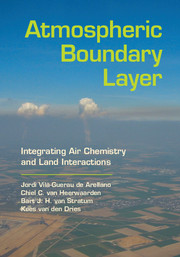Book contents
- Frontmatter
- Contents
- CLASS Software
- Preface
- Acknowledgments
- Part I The Land-Atmospheric Boundary Layer System
- Part II The Uncoupled System
- Part III The Coupled System
- Part IV Processes Related to Boundary Layer Clouds
- 14 Cloud-Topped Boundary Layer: Stratocumulus
- 15 The Partially Cloud-Topped Boundary Layer: Shallow Cumulus
- Part V User's Guide: CLASS Modules and Variables
- Appendices
- Bibliography
- Index
15 - The Partially Cloud-Topped Boundary Layer: Shallow Cumulus
from Part IV - Processes Related to Boundary Layer Clouds
Published online by Cambridge University Press: 05 July 2015
- Frontmatter
- Contents
- CLASS Software
- Preface
- Acknowledgments
- Part I The Land-Atmospheric Boundary Layer System
- Part II The Uncoupled System
- Part III The Coupled System
- Part IV Processes Related to Boundary Layer Clouds
- 14 Cloud-Topped Boundary Layer: Stratocumulus
- 15 The Partially Cloud-Topped Boundary Layer: Shallow Cumulus
- Part V User's Guide: CLASS Modules and Variables
- Appendices
- Bibliography
- Index
Summary
The Influence of Condensation on the ABL Dynamics
When rising air plumes that originate at the surface reach the saturation level, clouds form. A relevant boundary layer cloud type that enables us to observe the saturation of plumes at a specific level is shallow cumulus. Figure 15.1 shows the water vapour distribution in a diurnal boundary layer characterized by the presence of shallow cumulus (SCu) simulated by means of the large-eddy simulation technique. Two characteristic layers shown conceptually in Figure 15.2 are easy to recognize. A well-mixed layer (sub-cloud layer) is dominated by convective turbulence with θl and qt profiles constant on height (see Box 5.1 for the definition of the variables). This layer therefore resembles dynamically the clear boundary layer studied in Chapters 4 and 5. In this particular case (see Figure 15.1), above 1100 meters the cloud layer is characterized by two shallow cumuli extending to 1800 meters dominated by strong updrafts, whereas the rest of the layer above 1100 meters is mainly characterized by a stable stratified atmosphere. The amount of water vapour that has condensed in the cloud layer is quantified by the ql variable, namely, the liquid water content. It is important to stress that although the relative humidity in the top of the sub-cloud layer can be, on average, lower than 100 percent, shallow cumulus still form as a result of the higher content of moisture within the upward thermals (relative humidity ≈ 100 percent).
The presence of SCu can have a profound influence on surface processes and atmospheric phenomena in the lower part of the troposphere. They are small and have a cauliflower-like shape and their cloud base is usually very sharply defined. The vertical extent of shallow cumulus ranges between 1 and 2 kilometers with widths on the order of hundreds of meters. These clouds are convectively driven and developed when the boundary layer is heated from below by surface heat fluxes and when the moisture transported by the upward thermals condenses within the ABL.
- Type
- Chapter
- Information
- Atmospheric Boundary LayerIntegrating Air Chemistry and Land Interactions, pp. 190 - 212Publisher: Cambridge University PressPrint publication year: 2015

